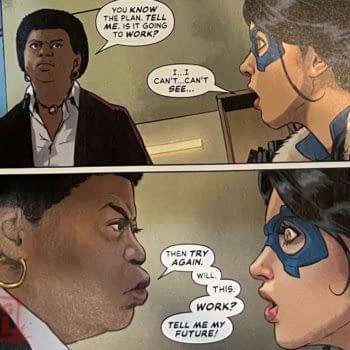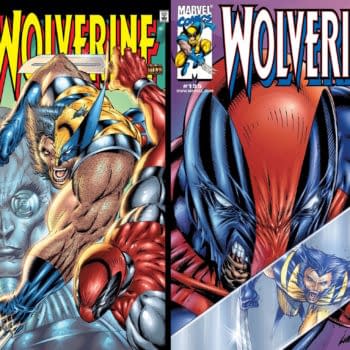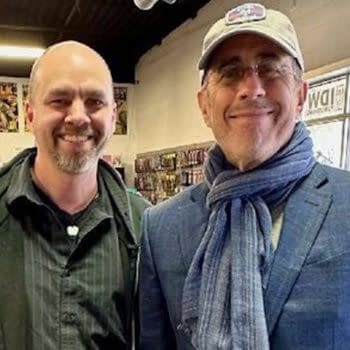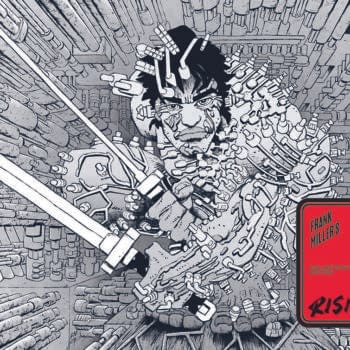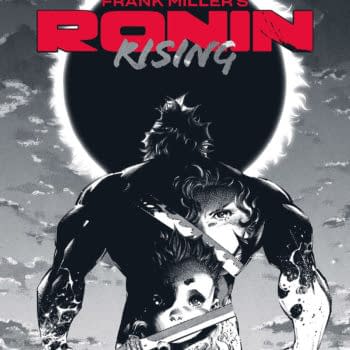Posted in: Comics, Recent Updates | Tagged:
Fashion, Design, and Accountability: Exploring Geek Chic at ECCC
Judd Morse writes,
Industry trendsetters gathered to talk shop in Sunday's Fashion, Comics, and the Rise of Geek Chic panel at Emerald City Comicon. Writer and teacher Dani Coleman moderated a panel made up of artists and creators as they touched on a wide variety of topics, including what it takes to make a character look great, how to balance creativity with editorial oversight, favorite designs and redesigns, and the different types of considerations that go into all design.
The panel was made up of The Wicked + The Divine and Jem and the Holograms artist Jen Bartel, Marvel's go-to redesign guy Kris Anka, creator and self-publishing guru Adam Withers, and cover artist Kevin Wata.
Coleman began by asking the panel what they thought it takes to make a character look fabulous. Withers replied that for him it depends on the character, and what that character thinks fabulous looks like. The most important thing about dressing a character is the personality of that character. Believability is essential, Bartel added. For Wata, the keyword is contemporary. His trick for establishing fabulousness is to take the most modern and fresh approach to design possible.
Coleman then asked a question directed more at Anka. Anka, who's overseen the redesigns of very relevant, recognizable big-name characters (think Spider-Woman and Captain Marvel), has a special insight into what it takes to do these large-scale redesigns. Coleman asked what it takes to do these kind of big redesigns on such well-known characters.
A lot of it is trying to determine what editorial is looking for, Anka replied. After that, it's a matter of time, and a matter of trial and error. His Spider-Woman design was a four-month process.
One of the cool things about designing for Marvel though is that Marvel allows for a lot of freedom of utility in their costumes, Anka said. Thanks to the existence of unstable molecules, Marvel costumes can literally be designed to catch fire, etc.
How do you design in the heightened reality that you base your work in, Coleman asked the panel. Suspension of belief is very important here, said Withers. You have to focus on the small details that you can control, and trust that the audience will forgive you for the big ones you can't. For example, he said, focus on making sure there's a seam line in a costume, and readers will forgive you for big things like the fact that Iron Man's helmet is way too small for his head. Figure out the rules for your book, he stressed, and then add the small details around them.
Do you ever return back to designs you've used before, asked Coleman. Anka said that he has, when the designs weren't used as they were intended. He used X-Force as an example; the costumes were absolutely not meant for casual wear. Psylocke wasn't meant to be wearing black everywhere all the time, he said, and stuff like that "irks the hell out of me."
As they design, the panel agreed that there have to be considerations made as to what effect their creations will have on a variety of different levels. Regarding stigmatizing sexuality, Withers said that often artist will use the excuse that a character is "confident in her sexuality," when in reality the artist just wants to draw her as close to naked as possible. Empathy is important in all design, added Bartel. How would it feel to wear the things I draw, she asked. That's something more male artists should consider.
As they design, the panel agreed that there have to be considerations made as to what effect their creations will have on a variety of different levels. Regarding stigmatizing sexuality, Withers said that often artist will use the excuse that a character is "confident in her sexuality," when in reality the artist just wants to draw her as close to naked as possible. Empathy is important in all design, added Bartel. How would it feel to wear the things I draw, she asked. That's something more male artists should consider.






